I have such noble intentions. I understand that new acquaintances might not always deduce that. For instance, that woman I called out on the corner of Broadway and Houston for throwing her cup on the ground might have been surprised when, after I called her lazy before realizing she was hammered at five on a Monday afternoon, received my middle finger and a laugh in response to her threat, “I’ll clean you so bad you won’t even know!” Certainly a small handful of supervisors and employers have been unsure of how to assess my exuberance, vehemence, volume, and proclamations at holiday parties. But I almost always start out on the right track.
Such is my way, I’m a bit ashamed to confess, with my gardens as well. To reach my flagship model, I have to scooch around Rachel and Tim’s hand-me-down futon, clamber over the garden paraphernalia and assorted whatever “stored” in that corner, thrust open the ancient window, leg it out on to the fire escape where I clamber over more paraphernalia, drop the ladder, and climb down. Every year I tell myself this is but a small hassle, and it’s not like I’m trying to grow dates in the West Bank. But every year I put a ton of work into my flagship only to have the tomato plants squeeze out a few handfuls of fruit, the beans sizzle into husks after one or two acceptable pickings, the melons stall at grapefruit size. Too often, I’m only pulling off C-level work.
And nothing less than a B was ever allowed in the Leahey household.
So this year I decided to step it up. A lot of the garden mediocrity was about water: I could set the sprinkler, but if I hoisted up the fire escape ladder and left the apartment, my downstairs neighbor inevitably turned the thing off. And I’m always gone during the day, always running for one job to another job to another job, always trying to get writing in. And then there’s the sheer waste of a sprinkler. So much water from a sp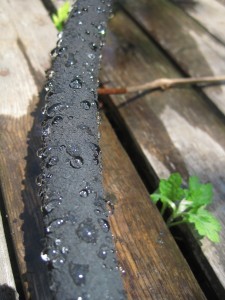 rinkler evaporates before it hydrates your plants. So much of it lands on pathways and driveways and concrete.
rinkler evaporates before it hydrates your plants. So much of it lands on pathways and driveways and concrete.
Enter: The Soaker Hose
I always thought soaker hoses were widely known about, but I’m starting to think I was wrong. Soaker hoses are recycled-rubber tubes that essentially perspire tiny water droplets when hooked to a spigot. They are stupendously! more efficient in terms of both water and dollars.
So check my A+ Noble Intentions Follow-Through 2014 Irrigation Set Up for Prosperous Harvests and Minimal Inconvenience or Effort:
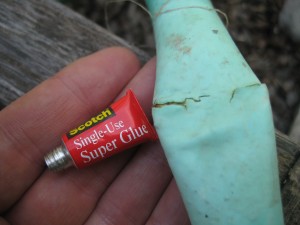 The whah whah Noble Intentions factors have on occasion included leaving the regular garden hose stretched out amongst the carcasses of the summer beneath months of bleak winter skies. Enter (single use!) Super Glue.
The whah whah Noble Intentions factors have on occasion included leaving the regular garden hose stretched out amongst the carcasses of the summer beneath months of bleak winter skies. Enter (single use!) Super Glue.
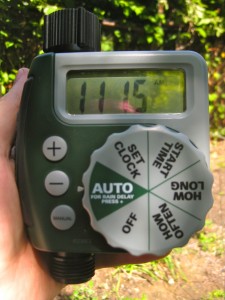 Irrigation Timers are the shit. You know those automatic light timers you use to run the lamps Home Alone-style when you’re on vacation? An irrigation does the same thing with your spigot. This one was made by a company named Orbit and cost something like 35 bucks. It runs on two AA batteries and is obvious and intuitive enough to be set up by a chimp or a toddler. I set mine to water for 45 minutes starting at 6:45 a.m. and then repeating twelve hours later.
Irrigation Timers are the shit. You know those automatic light timers you use to run the lamps Home Alone-style when you’re on vacation? An irrigation does the same thing with your spigot. This one was made by a company named Orbit and cost something like 35 bucks. It runs on two AA batteries and is obvious and intuitive enough to be set up by a chimp or a toddler. I set mine to water for 45 minutes starting at 6:45 a.m. and then repeating twelve hours later.
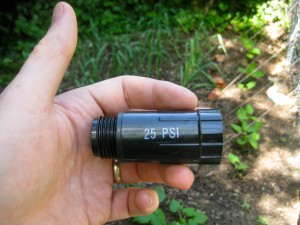 This is a pressure reducer that keeps the pounds per square inch at 25. Our building and its plumbing are old, poorly cared for, and not worthy of trust in any way. The pressure reducer keeps things flowing at a regular pace.
This is a pressure reducer that keeps the pounds per square inch at 25. Our building and its plumbing are old, poorly cared for, and not worthy of trust in any way. The pressure reducer keeps things flowing at a regular pace.
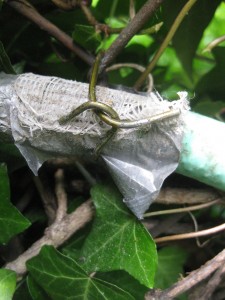 The part of the garden furthest away from the spigot happens to be slightly uphill and I wanted to use gravity as best I could. I cut a metal coat hanger into six-inch lengths and attached the garden hose to the fence so that the hose stayed more or less level until connecting to the soaker hose at the back of the garden. And, yeah, that’s duct tape on the hose. Backing up that Super Glue, don’t you know.
The part of the garden furthest away from the spigot happens to be slightly uphill and I wanted to use gravity as best I could. I cut a metal coat hanger into six-inch lengths and attached the garden hose to the fence so that the hose stayed more or less level until connecting to the soaker hose at the back of the garden. And, yeah, that’s duct tape on the hose. Backing up that Super Glue, don’t you know.
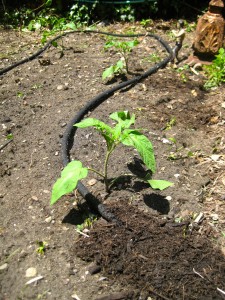 The soaker hose is fifty feet. I bought it for ten bucks at the Kmart at Astor Place. Home Depot was selling them for twenty. As I wound the hose around the plants, I covered it with mulch. This a) effectively eliminates evaporation and b) keeps the hose from deteriorating under the sun. This hose came with a ten-year guarantee.
The soaker hose is fifty feet. I bought it for ten bucks at the Kmart at Astor Place. Home Depot was selling them for twenty. As I wound the hose around the plants, I covered it with mulch. This a) effectively eliminates evaporation and b) keeps the hose from deteriorating under the sun. This hose came with a ten-year guarantee.
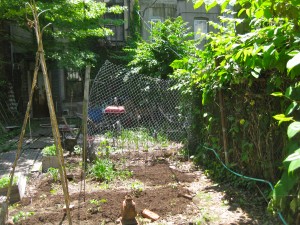 Done. Still trying to use recycled or found materials as much as possible, I used the strong, woody stalks of some of last year’s sunflowers to serve as support for the tomato plants since I ran out of cages. The fence (another tomato support, as well as bean support) was just lying in the backyard, as seems to be the way of many brownstone backyards. Dig it.
Done. Still trying to use recycled or found materials as much as possible, I used the strong, woody stalks of some of last year’s sunflowers to serve as support for the tomato plants since I ran out of cages. The fence (another tomato support, as well as bean support) was just lying in the backyard, as seems to be the way of many brownstone backyards. Dig it.
